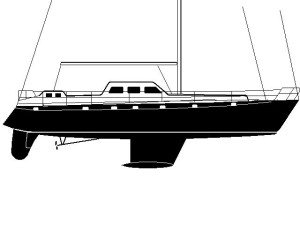Monohull, Cutter
65' x 18 Tons, Fin Keel
Series Drogue - 144 x 5" Dia. Cones
Force 9-10 Conditions
File D/M-16, obtained from John A. Traylor, Alta, Wyoming - Vessel name Beyond, hailing port Portland, Oregon, monohull cutter, designed by John Traylor, LOA 65' x LWL 56' x Beam 12' 8" x Draft 8' x 18 Tons - Fin keel - Drogue: Jordan series, 144 x 5" Diameter cones on 330' x 1"- 3/4"-5/8" nylon braid rode, with 24' of 3/8" chain at the end of the array - Deployed in a whole gale in deep water about 90 miles west of Point Conception, California, with winds of 40-60 knots and seas of 18-24 ft. - Vessel's stern yawed 10° - Drift was about 68 nm in 33 hours of deployment.
Before setting off on a major ocean passage John A. Traylor equipped Beyond with a number of drag devices, including a Para-Tech sea anchor and a Jordan series drogue. The series drogue was used in a gale off Point Conception. Transcript:
The drogue took me personally about 24 man hours to construct, from a kit sold by Dave Pelissier (Ace Sailmakers). Once I had tied a few cones on the rode, construction was easy, but of course boring! The tow-rope specified for our 18-ton cutter is: first third 1" nylon braid, second third 3/4" nylon, and the last third 5/8" nylon. Total number of cones: 144. We did fabricate a bridle, each leg being about 25 feet long, leading to large port and starboard bronze cleats on the stern. The end weight was four fathoms of 3/8" chain.
It took me about thirty minutes to bring the gear up from below and lash the bag into deployment position, and rig the bridle. The most difficult task was to remove the Aries vane (one of Nick Franklin's last models, which can be quickly dismounted). This was a bit dangerous - I had to go down into our stern "sugar scoop" and unhinge the vane, all the while watching for the next wave which might sweep the scoop. Once the Aries was secured, deployment was very easy. Just drop the chain off the stern and stand clear.
There was no noticeable shock [when the drogue took hold], but I could clearly see the heavy nylon rode stretching and squeezing the water out as it absorbed the load. We had been running under bare poles. Over a period of perhaps 40 seconds our speed dropped from 8 knots to about 1 3/4" (one and three-quarters) knots. The rudder was lashed amidships with a nylon bungee. There were no signs of rudder stresses. Chafe was not a problem throughout the duration of the 44 hour gale, but would have been if we had not removed the Aries vane gear.
Our vessel is 65 feet long and has a center cockpit. We had no water shipped in the cockpit, so I cannot comment on the performance of the cockpit drains, companionway, etc. The rather large "sugar scoop" stern was frequently swept by the cresting seas, and the noise was occasionally quite loud. On several occasions large waves broke astern and completely filled the "scoop." But the series drogue kept the hull very well aligned into the seas, with at most 10 degrees of occasional yaw. Once the long narrow hull was held stern to the seas, the wild ride was much smoother. Either my wife or myself stood watch in the deckhouse, where we could look astern and watch the seascape.
The gale abated rather quickly in the early hours of 27 October. The seas were quite lumpy and with no wind to steady the ship, the strain on the rigging was a concern. We decided to attempt to retrieve the drogue immediately, rather than wait for the light of dawn. With a rolling hitch on the bridle, and line led to our largest coaming winches, we found we could retrieve the drogue, albeit slowly, without damaging the cones. We were about 15 minutes into this process (and had retrieved about ¼ of the total) when my wife noticed a tanker to the northwest, already well over the horizon and with leading lights lined up directly on us. After two attempts to raise him on VHF with no response, we could now see the foam under his bow from the bright moon overhead. I had my wife standby with a knife, ready to cut away the drogue if necessary. But much to our relief we were able to "rouse the watch" on the ship by playing our 600,000 candlepower spotlight on our mast and finally, I must admit, on the bridge of the ship, perhaps a mile away! We soon heard a voice (Greek?) in unmistakably angry tones on the VHF. After a short explanation, he bore away and wished us "Bon Voyage!"
All in all, we were most pleased with the performance of the drogue. My main concern with our particular installation is the necessity to remove the Aries vane gear. This exposes the crew to some definite risk of injury. If the gear is left in place, it will eventually be destroyed and the series drogue will probably be lost as well. One would hope to foresee the onset of serious weather and make preparations in advance, but as our experience with the rapid (and poorly forecast) onset of this gale shows, this is not always possible.
Love the Drag Device Database? Help us to keep it free for all mariners by making a tiny donation to cover our server and maintenance costs. Thank You!
